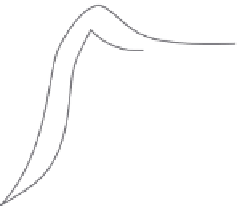Information Technology Reference
In-Depth Information
can closely track the changing network conditions, while making discrete
adjustments when needed in order to keep the conversational quality in a
user preferred state. Our system also performs better than the
p
-optimum
algorithm [13], which estimates conversational quality by a hybrid E-Model
and PESQ [4].
Lastly, we have integrated the classifiers learned into the design of a proto-
type VoIP system. The classifiers enable the systematic tuning of the control
algorithms in our prototype, without the need to carry out expensive subjec-
tive tests.
Multi-Party LC and PoS Schemes.
We observe that, from a client's (say
A) perspective, the decisions made by the POS of other clients in equalizing
MSs in the current turn do not affect the MS observed by A. Hence, A's deci-
sion can be assumed to be independent of the concurrent decisions made by
the other clients. Figure 2.11 extends the trade-off curve for the two-party
VoIP in Figure 2.7 to the multi-party case. It depicts two trade-off curves:
the curve connecting A, B, and C corresponds to a network condition with
high disparities in delays among the connections; and the curve connect-
ing A, B′ and C′ corresponds to a condition with similar average delay but
considerably less disparities. The control from A to B (
resp
., A to B′) is similar
to the two-party case: increasing the MED toward B (
resp.
, B′) conceals more
packets and improves LOSQ but degrades CS and CE. In the multi-party
case, further increasing the MED from B to C (
resp
., B′ to C′) to achieve full
equalization will lead to a high LOSQ with improved CS but degraded CE.
Hence, operating at C will result in a highly inefficient conversation with low
CE; whereas operating at C′ is relatively more efficient than at C.
We have developed control schemes that operate in conjunction with an
overlay network (described in the next section) in multi-party VoIP [10]. To
reduce the overhead and to improve loss adaptations, our LC scheme operates
B
C
B´
C´
Conversational
symmetry
Conversational
efficiency
Worse
A
Figure 2.11
Trade-offs under different multi-party conditions.
















